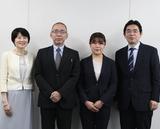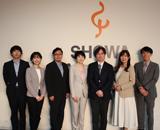August 2011
Sony Corporation: The Internal Communication Strategies of Multinational Japanese Companies
In the past, Japanese companies published in-house newsletters, which were circulated among all employees, to share the latest information related to the company. Today, with the enhancement of the Internet environment, many of these in-house publications are now moving towards becoming intranet websites. The intranet website not only serves a basic function of enabling the sharing of a company's vision or goals among employees but is now expanding the scope of its application to include such purposes as bidirectional communication among employees and the seamless sharing of information, inclusive of global sites and group companies. Today, Mariko Ohsato, together with Arc Communications' Yoshihiro Sato and Shinichiro Shibata, who were in charge of the Sony intranet website renewal project, is joined by Mr. Ueda and Ms. Mitoma of the Sony Corporation's Professional Solutions Group ("PSG") for a conversation on the PSG intranet website renewal.

Intranet Websites: An Important Mechanism for Sharing Visions and Goals
Ohsato: We were recently allowed to help renew the PSG intranet website. Can you begin by telling us a bit about PSG?
Ueda: The PSG is a division that is involved in B2B operations through the development and provision of video and imaging equipment geared toward television stations, companies in the film industry, and so on. We predominantly handle professional-use equipment, so I think you can think of us as a division that deals with state-of-the-art technology that has not yet become a universal technology incorporated in consumer products.
Ohsato: I see. So, it is a professional group in terms of technology. Can you give us the background to the recent order you placed with us?
Ueda: The business handled by the PSG includes not only the development of equipment for the broadcast industry but also various others businesses, such as surveillance cameras and other security-related equipment as well as FeliCa, which is a Japanese contactless IC card technology standard. There is a need to bring all of these businesses together, and there was opinion voiced that asked that we prepare a forum for communicating messages from management, such as the general manager and deputy general manager, related to policies and measures. That is why we decided to execute the re-upgrading of the intranet website.
Sato: The B-Square intranet website, which we renewed in this project, was already in existence. What was its reputation before the renewal?
Ueda: It was almost never viewed, so in that sense, it had no reputation to speak of. The information it contained was far from attractive, and in fact, there seems to have been many people who were not even aware of its existence.
Sato: So, you felt that making a fresh start for the B-Square would be a key point in improving internal communications. When we first talked with you about this project, I felt that you already had a firm vision for the intranet website.
Ueda: The first thing I thought of was my experience at the previous company I worked for, which was Sony Ericsson. The company holds an event every quarter in which employees come together from around the world. It consists not only of listening to speeches made by top management but also workshops, enjoying meals together, and so on. The event is a mechanism that enables people of different nationalities and backgrounds to share the same vision and goal. I had a strong recollection of this, and I wanted to include in the PSG intranet website the mechanism that this event served.
Ohsato: And so you consulted with us.
Ueda: In order for a newly-appointed general manager to communicate a message, in other words, visions and goals for sharing, in a way that resonates with each employee, there is a need to give a distinctive Sony flair to that information as well as to the means for communicating it. It has to be eye-friendly, and it also has to be "cool". We felt that getting help from professionals was indispensable, so that's why we consulted with Arc Communications.
Ohsato: When you first consulted with us, you said that communicating information to offices overseas was also important. What were your thoughts behind that?
Ueda: Development is basically carried out in Japan, so the primary role played by PSG offices outside Japan is that of sales. As such, the circumstances and line of work differs between Japan and our overseas offices. With that said, we are expected to share and aim to achieve the same goal, whether it is within or outside Japan. A platform for the global communication of information is indispensable if we are to do that. We are currently outsourcing the translation of the general manager's message, etc. to Arc Communications because we want professional quality. The communication of messages in English that are of a high quality and the sharing of information are very important.
Mitoma: There are many internal websites on the Sony Group's intranet, but the content of the PSG intranet website is becoming very rich, and in fact, I think our intranet website has the most number of articles in English.
Stronger Feedback from Overseas Readers!
Ohsato: I would imagine that the expectations and feelings toward the PSG intranet website were clear for management, but I get the feeling that those working on site may have a different perspective. Is there anything that you, Ms. Mitoma, see - as the person in charge of the intranet website's operation - as issues?
Mitoma: We have just under 20 people in our division who serve as monitors, and we execute various questionnaire surveys toward them. There is a strong desire for the enrichment of information that links people horizontally, and how we will go about achieving that will be a challenge. Furthermore, although I think that there has been a pretty significant increase in the amount of content offered, it is difficult to gather the opinions of those who are reading the intranet website, so I am curious to find out how it is being read. Readers from outside Japan send messages to us by email, but there is not much feedback to the intranet website coming in from Japanese offices. We do execute questionnaire surveys towards the monitors, but I think that the feedback we get from them reflects only the opinion of a very small group, so I think about whether there isn't some way that we can coax opinions out of the Japanese readers.
Sato: I think the feedback received from overseas offices will prove very valuable. Meanwhile, I think it is important that you include not only messages from superiors to subordinates but also enrich content about general employees in order to create an environment where it is easier for readers to express their opinions and reactions.
Shibata: In that sense, I think the information related to time spent off from work, which we proposed to you for the renewal, comprises content that is the easiest for people to react to. What kind of feedback are you getting?
Mitoma: Actually, it is very popular, and it gets an extremely large number of hits. We are thinking about creating some kind of mechanism which will steer readers from there to other content.
Sato: We help out the building of intranet websites at a variety of companies. An impression that I often get when seeing the content published in their intranet websites is that there is not very much about customers seen. Perhaps, because it is an internal website, there is a strong feeling that it should be information about the company and its employees and not about the customer. In other words, there is not much content that speaks about how customers may have felt about something.

Mitoma: Introducing the voice of those outside of the company is something that we really want to do with the PSG intranet website. We have recently started to publish interviews with people at sales companies on the intranet website. However, we have found it very difficult each time to cover an interview and write it up as content for publication on the intranet.
Ohsato: For things like that, one recommendation is that you ask a professional to handle it. It is difficult to communicate a message unless it is given a concrete form. Creating something from scratch can be quite difficult for someone without experience. If you ask a professional to do it initially will help to create a framework for the series, and you will begin to feel, "Okay, I think I can write that kind of thing."
Mitoma: You're right. Having a model to use in the beginning as reference would probably make the task much easier.
Feature Interview Index
















